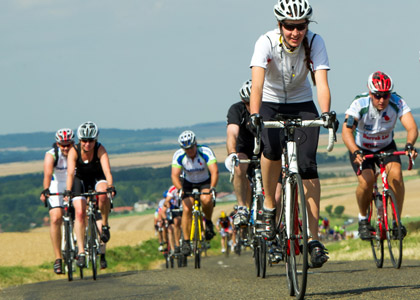How to cycle up a hill
To master cycling, you need to be able to conquer those dreaded hills day in day out. Whether you’re a complete beginner, at intermediate level or an ultra-distance endurance cyclist, the same basic principles apply when it comes to tackling those blasted hills. And we guarantee, that the smarter you train, the easier they become…we promise! Our friends at Team Njinga (the cycling tours and training experts) give us their top tips: Mentally Prepare Yourself A key problem for a lot of cyclists is their negative attitude towards hills which leaves them defeated before they’ve even started the incline. A fundamental aspect of hill climbing is mentally preparing yourself for the challenge in advance and remaining positive that you can do it. Key

To master cycling, you need to be able to conquer those dreaded hills day in day out. Whether you’re a complete beginner, at intermediate level or an ultra-distance endurance cyclist, the same basic principles apply when it comes to tackling those blasted hills.
And we guarantee, that the smarter you train, the easier they become…we promise!
Our friends at Team Njinga (the cycling tours and training experts) give us their top tips:

Mentally Prepare Yourself
A key problem for a lot of cyclists is their negative attitude towards hills which leaves them defeated before they’ve even started the incline. A fundamental aspect of hill climbing is mentally preparing yourself for the challenge in advance and remaining positive that you can do it.
Key Tip: Visualise the hill on your route, break it down into manageable chunks and set mini goals.
Choose the correct gear
It’s critical before attempting any major hill climb that you understand how to use your gears properly. This is a key skill to master as it has a dramatic impact on your ability to climb with the least possible effort (sounds good to us!).
In order to be able to use your gears more efficiently, you need to constantly be looking ahead so you can monitor the terrain and thus anticipate the ideal gear. This will allow you to shift into the correct one just before the gradient changes, not once you’ve already reached the hill. You don’t want anything creeping up on you in surprise!
You should also keep pedalling while you change gears in order to maintain momentum; the key is to keep your effort as constant as possible. In general, a low gear (easy) is needed for going uphill while a high gear (hard) is needed for descending.
Key Tip: Anticipate what is happening ahead of you on the road to determine the most appropriate gear to use.

Start in your seat
Hill climbing can take its toll on the body so it’s best to be as economical as possible by staying in the saddle for as long as possible – this is the most aerobically efficient way to the top!
As a general rule, for long gentle climbs it’s more efficient to stay seated while short steep climbs it may be tactically beneficial to get out of the saddle and power up. But remember, the longer the climb and harder the force you exert on the pedals out of the saddle, the more energy you expend. With declining energy over the duration of a cycle, you want to try and conserve this as much as possible.
When standing out of the saddle, make sure you switch your gear selection to one or two gears harder (unless the gradient suddenly spikes up) as you don’t want it to be so easy that you struggle to pedal and lose momentum. Likewise you don’t want to make the gear so hard that you end up losing your form and rocking from side to side as this is inefficient and can be an absolute energy sapper!
Key Tip: When standing out of the saddle it’s important to place your hands on the hoods (the part that attaches onto the handle bars) for maximum stability.
When to eat
As mentioned earlier for gear changing, anticipating the terrain ahead is also critical when it comes to fuelling your body as you need to be consuming enough energy to get to the top! Why not make your own energy bombs with our fab homemade recipe? They work wonders, are easy to carry and taste delicious!
Make sure you experiment with the quantity of food that you consume as it depends on the duration and grade of the hill. You want to ensure you have enough energy to get you to the top at your desired steady pace without being caught having to hill climb and eat at the same time.
Key Tip: Try to eat your energy food just before a big hill climb.
Cadence (rate at which you pedal)
Maintaining a steady cadence of around 90 RPM (revolutions per minute) is ideal when trying to keep at a long distance steady pace. If you don’t have a cadence meter on your bike then try to ensure you are in a gear where you can climb the hill at a pace where your legs are able to spin comfortably without undue force i.e. not slowly where you struggle even a little bit, or so fast that it’s more a flip flop effect where you feel your feet are slipping or pushing down on air.
Key Tip: Buy a cadence meter like a Garmin, Polar or Cat Eye to effectively monitor your RPM.
Chill
Try to relax and not to get too stressed about climbing hills as that tension is wasted energy and you won’t enjoy yourself.
Now go have some fun on your bike!
More info: www.njingacycling.com
Lizzie Flint, Sportsister
The Women’s Sports Magazine
SOURCE: Sportsister – Read entire story here.








